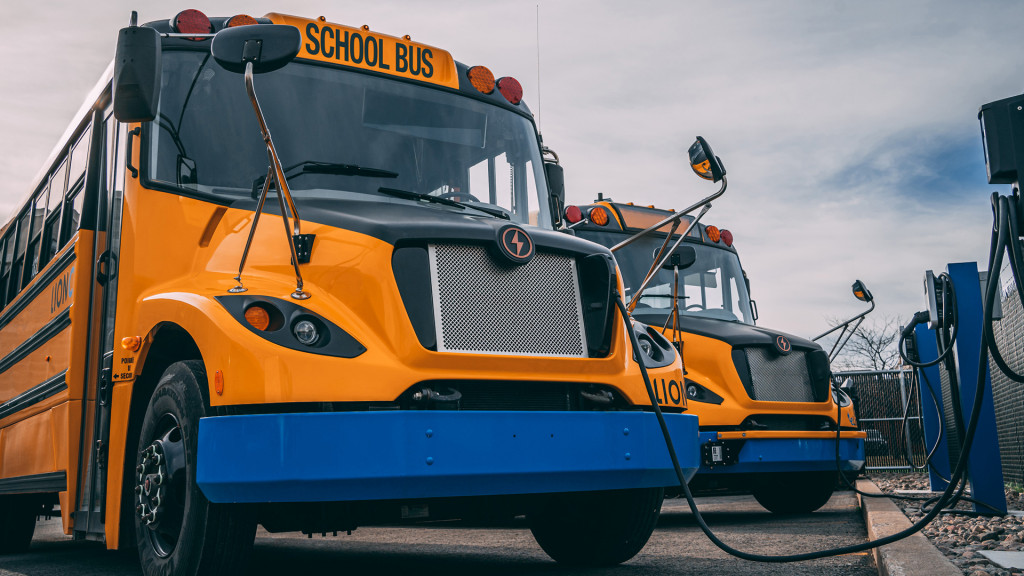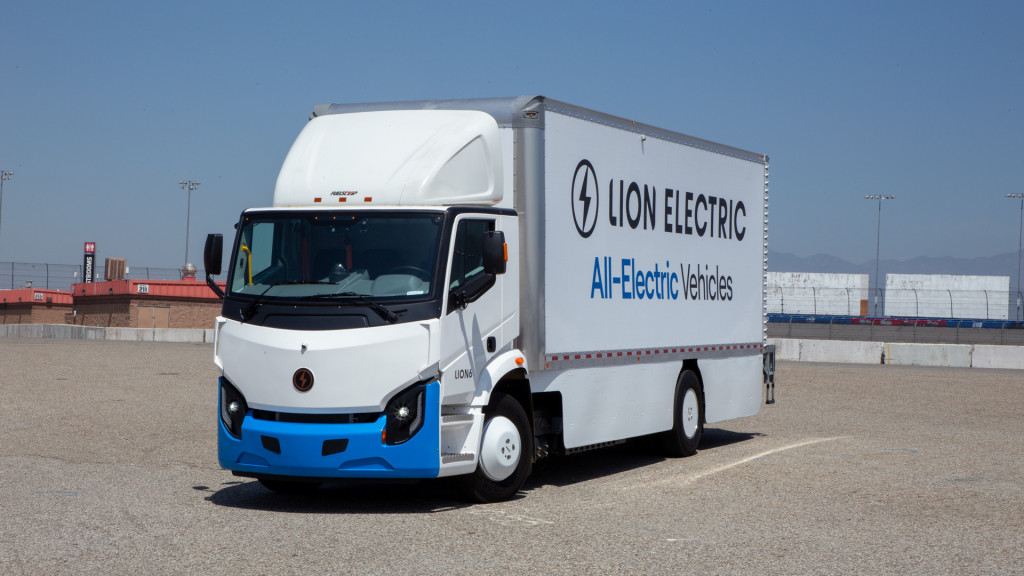Like most American school children, I have enduring memories of traveling in big yellow school buses and inhaling big diesel fumes.
Companies like Lion Electric are looking to change the diesel school bus experience by offering a trio of electric school buses that will transform and make greener (not yellower) the school commute for students across the country.
Electric school buses are ideal for large commercial adoption, they are the largest form of public transportation with 480,000 in service on school days. They generally don’t drive very long routes, they stop and start frequently, and they have wide predictable periods of down time. This would allow a school to use one even without the installation of higher voltage fast chargers on site. Level 2 charging would be enough to get the buses charged up overnight or even as they idle during the school day and it’s much cheaper/easier to install than a DC quick charging station.
The EPA has also targeted school buses as a way to reduce pollution widely and the agency recently announced details to its $5 billion electric school bus program, including an initial installment of $500 million as a part of the latest infrastructure bill. The program includes a lottery to receive funding and prioritizes applications to replace internal-combustion buses in high-need, rural, and Tribal areas. And the rebate program doesn’t only apply to the vehicles, it applies to the installation of needed charging hardware as well.
Lion 6 Electric Truck
To get a sense of what these electric school buses will be like, I traveled to the Auto Club Speedway in Fontana, Calif., to get some time behind the wheel of the Lion 6 commercial truck that shares a class-7 chassis with the Lion A and C school buses (the buses weren’t available for us to test at this event). There’s a big difference in the heights of the vehicles, but from a driving standpoint the two should be pretty similar with the same power output. We unfortunately didn’t get to take the truck on the NASCAR-ready oval track, but the infield course had been repurposed for test drives of the Lion6 and several other commercially available electric trucks.
Lion offers several battery and range configurations for the Lion 6 and the school bus as well. The version I tested came with the largest battery setup. Three battery packs were mounted around the frame (two in the middle, one in the rear) for a total of 252 kwh and 200 miles of estimated range. On the school buses, range will drop down to an estimated 155 miles. The packs are composed of a pair of 42.2 kwh BMW i3 battery packs stacked top of one another, so they can be cooled concurrently. Power figures check in at 335 hp and 1,800 lb-ft of torque, at maximum.
The first thing you notice when driving these large vehicles with electric drivetrains is how easy it all seems. Hop into the seat, push a button to put the vehicle into drive, release the airbrake, and roll away. Thanks to all of that instant torque from the electric motors, acceleration is surprisingly linear and it makes these vehicles feel smaller than they actually are (I felt the same sensation testing Thomas’ Jouley electric bus last year). If not for the oversized steering wheel, it would feel much like driving a big SUV or an HD truck.
As good as a diesel engine might be at low-rpm torque generation, it isn’t in the same class as an electric motor that requires no spinning up. Driving a truck without the diesel hum takes some getting used to. It’s eerily quiet in the Lion 6’s cabin minus the sounds of the air suspension bounding on the track’s uneven surface.
The Lion6 doesn’t offer different regen levels. It keeps it simple with what I’d describe as a medium amount of regen that’s very noticeable if you lift off suddenly but still requires the brakes to slow the truck to a complete stop. Lion representatives said this was to give truck and bus operators less complexity as they adapt to electric vehicles, and to prevent drivers from turning off the regen for initial ease-of-use that would undermine some of the efficiency that these vehicles are trying to deliver.

Lion C Electric School Bus
Lion lists charging times as 11 hours on a Level 2 charger, which drops down to around four hours on a 50-kw DC-fast charger. That’s plenty of time to get a school bus charged up overnight. Lion also says another advantage of an electric school bus is that it can be cooled or heated while plugged in and idle, in preparation for a route. On a diesel bus, the engine would need to be running for that to take place and that contributes to the amount of emissions a school bus produces over its lifetime.
Lion Electric’s three school buses make up a large percentage of the company’s future sales. Of the 2,422 vehicles in its current order book, nearly 90 % of that (2,136 vehicles) are electric school buses. And the company has detailed plans to open up a large plant to build electric buses and HD commercial trucks in Joliet, Illinois, by the end of the year. The plant will have a capacity of 20,000 vehicles, and Lion says it will scale up production to match orders and demand. The company’s current plant in Canada only has the capacity to produce 2,500 vehicles, so this is a gigantic upgrade in its ability to produce these vehicles.
In addition to the Illinois plant, Lion also plans to open up a battery factory of its own in Quebec later this year and batteries from that facility will begin to show up in Lion vehicles by the end of the year. That factory will have an eventual 5 gigawatt-hours of production capacity annually, or enough batteries for 14,000 commercial vehicles per year. It also gives the company better control over the form factor and size of its batteries to better integrate them into the various chassis that Lion offers.
It’s encouraging to see government investment and private sector production ramp up in lockstep to address environmental and emissions concerns. School kids will still get to make their own yellow school bus memories, but this time they won’t be so stinky.

order lasuna – lasuna without prescription himcolin pill
buy besifloxacin online – buy carbocisteine medication buy sildamax online
probalan drug – buy cheap generic benemid tegretol 400mg us
buy cheap celecoxib – urispas order indocin 75mg cost
buy colospa 135mg generic – cilostazol 100mg tablet cilostazol 100 mg price
generic diclofenac 50mg – order aspirin 75mg pills aspirin 75 mg usa
buy pyridostigmine generic – order imitrex azathioprine order online
rumalaya tablets – rumalaya oral endep cost
baclofen online – order lioresal generic order piroxicam sale
diclofenac usa – order voveran online how to buy nimodipine
cyproheptadine for sale – buy cyproheptadine online cheap tizanidine 2mg generic
buy meloxicam without prescription – order toradol 10mg online ketorolac sale
buy omnicef generic – buy omnicef online clindamycin canada
purchase artane online cheap – trihexyphenidyl price buy diclofenac gel sale
buy prednisone 40mg generic – cost omnacortil 40mg order permethrin online cheap
order accutane pills – order generic dapsone purchase deltasone generic
purchase permethrin for sale – order tretinoin cream without prescription cost tretinoin cream
buy betnovate 20gm – betamethasone 20gm us purchase benoquin online
flagyl 200mg ca – buy metronidazole 400mg generic buy cenforce 50mg
buy augmentin 1000mg generic – order augmentin 1000mg without prescription brand synthroid 75mcg
buy hyzaar online – cozaar 25mg us order cephalexin 125mg generic
order cleocin 150mg online cheap – cleocin 150mg without prescription indomethacin 50mg tablet
buy modafinil 100mg pill – order provigil 200mg sale meloset over the counter
order eurax for sale – bactroban ointment tablet purchase aczone sale
cost zyban – ayurslim brand purchase shuddha guggulu generic
order xeloda 500 mg pills – where to buy naprosyn without a prescription buy danocrine pills
buy progesterone 200mg generic – order clomiphene pills buy fertomid pill
buy fosamax 35mg generic – generic pilex order provera 10mg generic
purchase yasmin – order generic letrozole 2.5 mg buy arimidex 1mg generic
cabergoline sale – buy cabergoline order alesse online
гѓ—гѓ¬гѓ‰гѓ‹гѓігЃЇи–¬е±ЂгЃ§иІ·гЃ€г‚‹пјџ – г‚ёг‚№гѓгѓћгѓѓг‚ЇйЂљиІ©гЃЉгЃ™гЃ™г‚Ѓ г‚ёг‚№гѓгѓћгѓѓг‚ЇгЃЇи–¬е±ЂгЃ§иІ·гЃ€г‚‹пјџ
гѓ—гѓ¬гѓ‰гѓ‹гѓі её‚иІ© гЃЉгЃ™гЃ™г‚Ѓ – гѓ—гѓ¬гѓ‰гѓ‹гѓі и–¬е±ЂгЃ§иІ·гЃ€г‚‹ жЈи¦Џе“Ѓг‚¤г‚Ѕгѓ€гѓ¬гѓЃгѓЋг‚¤гѓійЊ гЃ®жЈгЃ—い処方
eriacta half – eriacta service forzest inn
valif online eater – valif pills plain sinemet brand
crixivan where to buy – buy emulgel for sale purchase diclofenac gel sale
phenergan where to buy – purchase lincomycin without prescription order lincocin 500 mg generic
ivermectin 12 mg without a doctor prescription – tegretol 200mg sale carbamazepine pills
purchase prednisone generic – generic prednisone 40mg buy captopril 25 mg pill
buy deltasone 20mg generic – buy generic nateglinide 120mg capoten uk
accutane order online – isotretinoin 10mg generic buy linezolid 600mg for sale
buy cheap amoxil – combivent 100 mcg canada combivent 100mcg sale